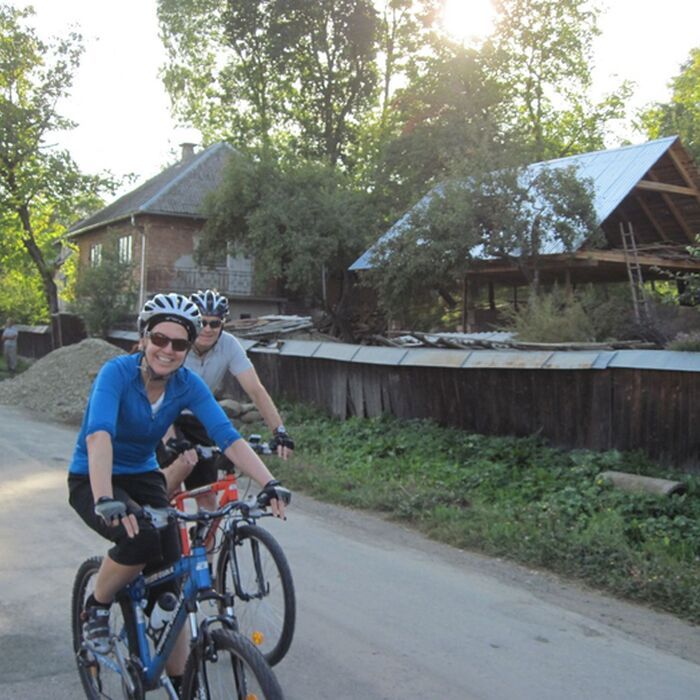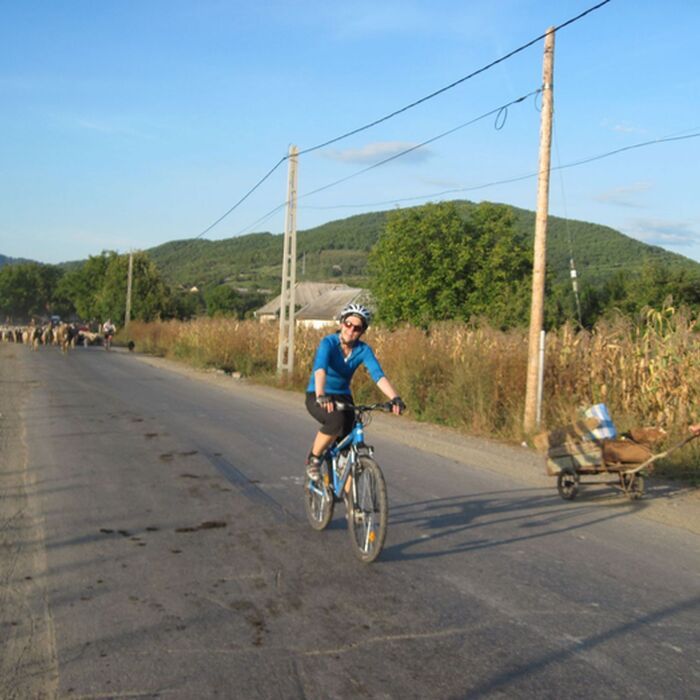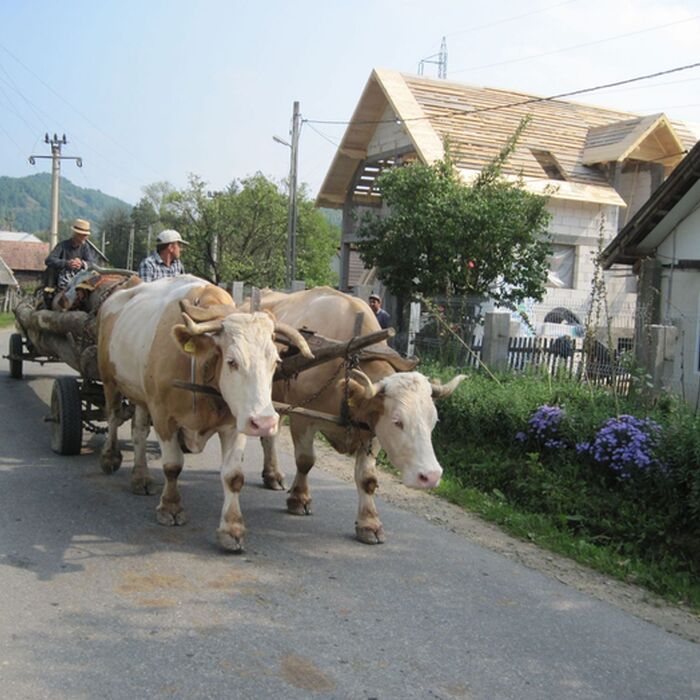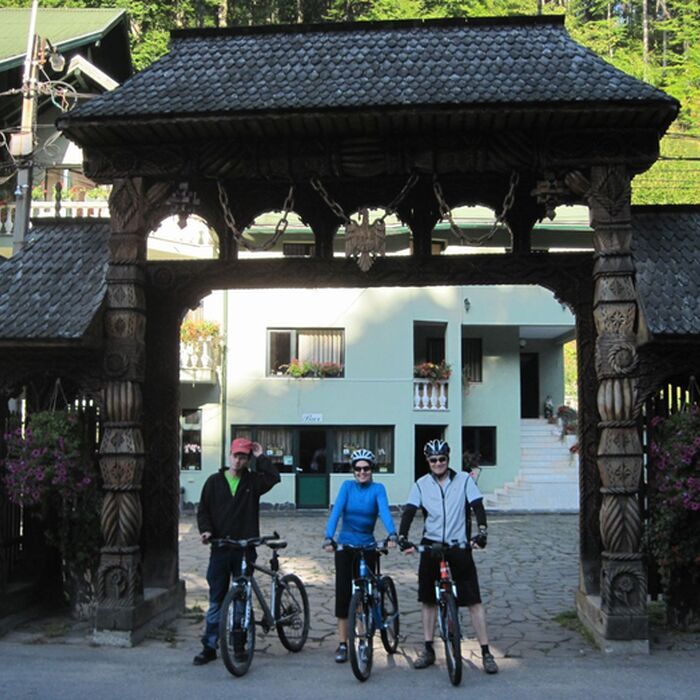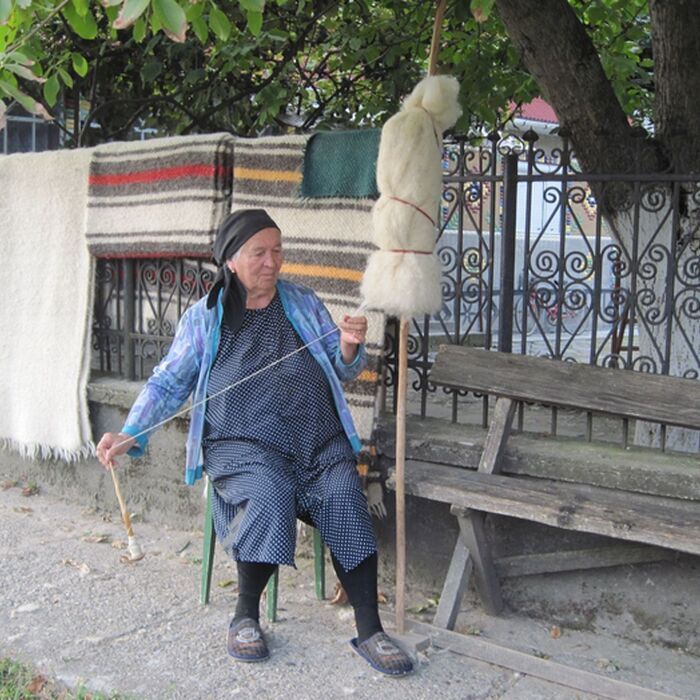Maramures and Transylvania heritage cycling tour - 9 days
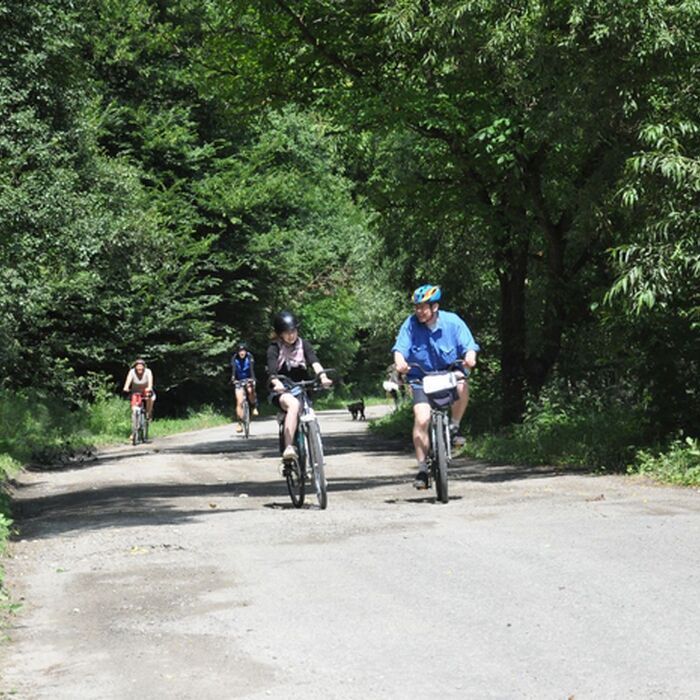



| Age range | 12-99 |
| Country Region | Baia Mare, Biertan, Breb, Bucharest, Cartisoara, Curtea de Arges, Sibiu, Sighetu Marmatiei, Sighisoara |
| Difficulty | Medium |
| Number of days | 9 |
| Operating languages | English, Romanian |
| Points of interest | Astra Open Air Village Museum, Balea Lake, Balea Waterfall, Biertan Fortified Church, Maramures timber churches, Poienari Fortress, Sapanta Merry Cemetery, Transfagarasan road, Vidradu Dam |
| Tour type | Active Adventure, Biking, Explorer, Family, In-depth Cultural, Meeting the locals, Private tour, Unesco Heritage Site Tour |
Description Maramures and Transylvania heritage cycling tour - 9 days
Maramures - the Land of Woods and Rivers!
Rates:
- 2999 euros/person for a group of 2
- 2399 euros/person for a group of 4
- 1999 euros/person for a group of 6
The package includes:
- 8 nights accommodation
- Full board for all periods - Breakfasts, Dinners, and Lunches to go
- All entrances to monuments included in the itinerary
- Luggage transportation
- Vehicle Assistance (whenever roads allow it to pass)
- English-speaking accompanying bike guide
- Souvenirs
- Mountainbikes and helmets
Not included:
- Airfare
- Alcoholic drinks
- Extra charges for laundry, telephone, room service, etc.
- Insurance
- Transport from the airport or station to Baia Mare and back to the airport or train station
- Participants should reach the meeting point at the proposed time. If necessary, we will provide customers with transportation support (from the airport or to another destination point), ticket reservation, equipment rental, and other related services.
- Additional local guides
Maramures & The Heritage of Transylvania cycling tour
Day 1:
GET TOGETHER IN BAIA MARE
- Visiting Baia Mare (cultural, historic visit, and shopping). Transfers from Cluj are available, inquire for details
- Dinner at Lostrita restaurant -16 km from Baia Mare, near Lake Firiza
- Alternative: 10 km cycling from Firiza Lake to Izvoare. Dinner at Izvoare, 25 km from Baia Mare. Accommodation in a *** hotel.
- Baia Mare, the county town of Maramures, is situated on the Sasar river, at the base of the Gutai Mountains. In the old part of the town, we can admire a few old structures and monuments such as „St Steven Tower“, „St Anthony Catholic Church“, The Elizabeth House, The Butcher's Bastille, Monetare Bastille, and other Orthodox, Reformed, and Catholic churches. The Mineral Museum represents an interesting attraction and is unique to the country.
Uphill/Downhill cycling: 100m/100m, cycling distance: 10km, cycling time: 1h
Day 2:
Cycling tour: IZVOARE - PASUL GUTAI - MOGOSA - CAVNIC - BUDESTI - BREB - OCNA SUGATAG - CALINESTI - VALENI – BARSANA ~ 80 KM
- After we take breakfast, we begin our trip at around 8.30 a.m. From Izvoare, we will cycle for about 12 km on a pleasant forest path to Gutai Clough (1,000 m), which lies on the route from Baia Mare to Sighetu Marmatiei. The road passes to the east of the Ignis Peak of the Ignis Mountains by crossing a coniferous forest. At the Gutai Clough, there is a lovely traditional restaurant called Hanul Pintea, where we could have a rest. From Gutai, we cycle 10 km on an asphalt road, descending to Baia Mare, then continue for 3 km on a secondary road to Mogosa. From Mogosa, the route takes us to the centre of the tourist city of Cavnic. Here we could pay a visit to the ruins of a gold mine dating back to the 19th century; The Tartars pole (Piatra Tatarilor), The Written Stone (Piatra Scrisa), The King's Garden (Gradina Regelui) - a glade and a 250-year-old forest of larch, which is a natural reservation. Cavnic is an old mining town situated in the Gutai mountains.
The road continues for 8 km on a local road to Neteda Clough (1,040 m), then descends 15 km to Calinesti (500 m). Thus, we enter the Maramures depression. On your way to Breb village, you will notice several wooden structures along the riverside, including Valtori for washing clothes and blankets, water mills that operate all day, and traditional distilleries that produce the strong plum brandy called horinca. These are locations where local people can meet and chat.
- Breb is also famous for having been visited by the Prince of Wales in the spring of 2004. Here are three traditional wooden houses bought by the Mihai Eminescu Trust (whose royal patron is the Prince of Wales). At Budesti or Ocna Sugatag (a famous resort nowadays), we might stop for a traditional lunch. The community dates back to 1360, when the main occupation here was salt mining. Thus, the name of the village, "ocna," means salt mine. Today, Ocna Sugatag is a popular health spa which stands out through its hot or cold salty baths and the lake formed when the salt mine collapsed. From Ocna Sugatag, our route takes us after 14 km to Barsana, passing the villages of Calinesti and Valeni. In Calinesti, we can admire one of the most beautiful Maramures gates. The village of Barsana is 12 kilometers from Vadu-Izei. Barsana is one of the larger communes in Maramures and one of the most important villages in the Iza River valley. Barsana can trace its history back to the Bronze Age. The 57 m-high church of the Barsana monastery ranks first among Romania's wooden structures. The church, which now stands on a small hill surrounded by an orchard, is one of eight churches on UNESCO's World Heritage List. In addition to its history, Barsana is worth visiting for its beautiful traditional gates, friendly, hard-working people, and stunning scenery.
- Overnight accommodation in the area at a local pension or guest house.
Uphill/Downhill cycling: 400m/500m, cycling distance: 80km, cycling time: 7h
Day 3:
Cycling tour: BARSANA - STRAMTURA - ROZAVLEA - IEUD - BOGDAN VODA - SALISTEA DE SUS - SACEL - MOISEI - VISEU DE SUS - VISEU DE JOS ~ 75 KM
(Alternative route): Barsana-Slatioara-Glod-Poienile Izei-Botiza-Ieud-Bogdan Voda-Salistea de Sus-Sacel-Moisei-Viseu de Sus-Viseu de Jos ~ 85 km
- As usual, we leave for our cycling tour after breakfast around 9.30 a.m. Be careful that this is the longest cycling day of our tour. It is an easier route since most of it is an asphalt road. Participants are asked to be careful and use their energy as efficiently as possible, especially if we have a very hot or rainy day.
- From Barsana, we enter the beautiful Iza Valley, one of the finest cycling areas in Maramures. Iza River springs from the Rodna Massif and flows for 80 km across the county, eventually joining the Tisa at Sighet. The villages here exhibit superb old wooden churches and traditional peasant houses. We have two alternatives to reach Ieud village: either follow the asphalt road for 25 km, or take the longer option, which is ~10 km. The road is very nice and follows the small rivers of Sieut, Botiza, and Ieud. On the road, we could stop in Stramtura to admire the wooden church built in 1667.
- Ieud is known for the preservation of its traditional customs as well as its traditional architecture. The people here dress and act the same as they did hundreds of years ago. Every year in July, the people of Ieud celebrate with a multi-day festival of traditional culture called "Ieud Cultural Days". From Ieud, we re-enter the Iza valley and pass through the villages of Bogdan Voda, Sacel (where unglazed ceramic is still produced), and Moisei, covering a total distance of 31 km on an easy asphalt road.
- After another 19 km on an asphalt road, we are entering the Viseu valley. Viseu Valley spans a 60-kilometer stretch of scenic countryside and villages known for their traditional folklore and historical value. Romanians, Germans, and Carpatho-Russians inhabit the area, offering accommodation in a beautiful traditional house in Viseu de Jos.
Uphill/Downhill cycling: 200m/200m, cycling distance: 85km, cycling time: 8h
Day 4:
Cycling tour: VISEU DE JOS - RUSCOVA - PETROVA - BARSANA - NANESTI - ONCESTI - VADU IZEI - SIGHETU MARMATIEI - SARASAU - CAMPULUNG LA TISA - SAPANTA~ 78 KM
- Departure is scheduled as usual at 9.30 a.m., after having breakfast. We travel 25 km through the valley of the River Viseu, where we encounter a 6 km ascent to Petrova. From there, we will cycle downhill for about 10 km through beautiful scenery. After we reach Barsan, we follow the road to Sighetul Marmatiei for 13 km via Nanesti and Oncesti. We reach Vadu Izei, a very nice hill landscape. Vadu Izei is at the confluence of the Mara and Iza Rivers. Surrounded by hills and situated on a small plain only a few square kilometers in size, Vadu Izei stands beside these two rivers.
- The picturesque meadows and estuaries in the area shelter many species of birds with spectacular songs and colors. The hills are covered with apple, plum, and cherry orchards, giving way to thick forests of pine and oak in many places. The village is well known for its impressive, traditional, wooden gates carved by Gheorghe Borodi, the songs of Maria Trifoi, the melodies played by violinist Gheorghe Covaci Cioata, Tiberiu Utan's poetry, and the magnificent drawings of Vasile Kazar. In Vadu Izei, we may visit local traditional houses for wood sculpture, glass icon painting, wool blankets, and carpet weavers.
- We travel to Sighetu Marmatiei for about 6 km. Before reaching the city, we could stop and visit the Maramures village museum situated on the Dobaies Hill, 300 km from the main road. The museum, located on a beautiful hill, showcases traditional wooden houses and households from all over Maramures. An elegant wooden church graciously rules over the thoroughly recreated village. You can relax in the peaceful landscape while discovering age-old lifestyles and ancient crafts.
- We stop in the city to visit some of the sights. From Sighetu Marmatiei to Sapanta (300 m altitude), we cycle about 16 km parallel to the Ukrainian border. Alternatively, we can go up to the Tisa River - the natural border between Romania and Ukraine.
- Lying on the banks of the Tisa, the river that forms the frontier with Ukraine, towered over by the Carpathian Mountains, Sapanta is a commune with five thousand inhabitants, not much different from others in Maramures, a province in northern Romania. The inhabitants of Sapanta strictly obey the traditions of the Orthodox religion and are fervent believers. It is a duty, even an honour, to be part of the church committee. On Sunday, everybody, young and old, dresses in the national costume and tries to forget old feuds. The Merry Cemetery of Sapanta has been, for more than fifty years, the creation of sculptor Stan Patras, the successor to several generations of woodcarvers who bequeathed their trade from father to son.
- The phrase "merry cemetery" may seem paradoxical if not even touching impiety. His crosses make up a whole world, a living chronicle of a community that spans generations. A true kaleidoscope of dances, crafts, songs, sermons, thoughts, songs to Mother Nature - that is the meaning of these crosses that surround a small church.. In the cemetery surrounding the church in Sapanta, the crosses are carved and painted from wood. The graves resemble flower beds, and the crosses themselves rise like large, colourful flowers. In summertime, this is a popular pilgrimage site.
- We will spend the night in the guest house, situated close to Sapanta Monastery.
Uphill/Downhill cycling: 200m/200m, cycling distance: 78km, cycling time: 7h
Day 5: Breakfast. Transfer Sapanta – Sighisoara (UNESCO World Heritage Site) – 350 km – around 5 - 6 hours drive. Accommodation.
Day 6: After breakfast, we continue exploring the hilly region with fortified churches west of Sighisoara. The cycling starts 25 kilometers from Sighisoara on a small, peaceful road, passing through agricultural lands, small villages, and 4 fortified churches – Biertan (UNESCO World Heritage site), Richis, Altina, and Hosman - dating back to the 14th to 16th centuries. Today we finish in the beautiful city of Sibiu (European capital of culture 2007). Free time for walks in the old town.
Uphill/downhill cycling: 500/480m, distance: 78km, cycling time: 6h /breakfast/
Day 7: Breakfast. In the morning, we take a short walk through the second-largest open-air museum in Europe, located near Sibiu (Astra Open-Air Museum). You will enjoy a walk through the park's alleys, admiring the fine architecture of villages from different regions of Romania. A short transfer to Cartisoara village brings us to the foothills of the Fagaras mountains, where we begin biking on the spectacular Transfagarasan road. First, we climb through nice coniferous forests and reach the cabin lift station, where we can have lunch in a small restaurant. Once you get to the tree line at about 1600 m, the alpine landscapes of the Fagars mountains will reveal their beauty to you. You will pass near the cascade waterfalls Balea and continue cycling on the numerous serpentines climbing gradually in the valley until you reach the picturesque region of Balea Lake at 2030m, where you stay overnight. Free time for afternoon hikes around the lake.
Uphill cycling: 1400m, cycling distance: 25km, cycling time: 5h
Day 8: After breakfast and a short transfer through the longest tunnel in Romania (900m), we begin biking downhill, exploring the southern slopes of the Fagaras Mountains and the spectacular Transfagarasan road. After we leave the alpine landscapes, we enter the green gorge of the Arges River and reach the spectacular Vidraru dam (165m high dam wall). Nearby is the Poenari Fortress (former residence of Vlad Tepes, also known as Dracula) and the Prometheus sculpture. We continue cycling downhill through nice forested areas, passing by a few waterfalls, and finish cycling in Curtea de Arges (one of the oldest towns in Romania)—transfer (150km, three hours) to Bucharest for overnight.
Downhill cycling: 1500m, cycling distance: 70km, cycling time: 4h
Day 9: Breakfast. Transfer to the airport for departure.
Details about the biking tour:
- optimal time: July - October
- number of participants: minimum 4, maximum 14.
- Transportation will be chosen according to the number of participants.
- Biking tour requires a good physical shape, with resistance to low effort, but for a long duration.
- licensed mountain guide during the entire biking tour.
Special highlights:
Cycle along the Iza and Mara river valleys to admire the beautiful scenery.
The "Merry Cemetery " in Sapanta, unique in the world, is impressive due to its originality.
Visit the wooden churches, part of the Unesco World Heritage.
Botiza village (dowry chests and rugs).
Viseul de Jos area (folk costume and fabrics).
Bogdan Voda village (carpets and wickerwork).
Sacel village (rough red ceramics with old traditional elements).
Sighisoara - A European treasure, Sighisoara is a UNESCO World Heritage Site. Located on the Tarnava Mare River, the town was built by Saxons between the 12th and 17th centuries. Eleven towers guard Sighisoara's walls, among them Tailors' Tower and Shoemakers' Tower.
Biertan - The village is known for its 14th-century fortified church. It is a UNESCO World Heritage site.
Sibiu, the cultural capital of Europe in 2007, was once the king of the Transylvanian Saxon towns, serving as capital and dominating cultural activity. Sibiu is home to the first hospital in Romania (1292), the first pharmacy (1494), and the oldest museum in Romania, the Brukenthal Museum, opened in 1817.
Astra Open Air Village Museum, the second-largest open-air museum in Europe (250 acres), is located in the middle of a dense forest, surrounded by a beautiful lake. It features more than 300 buildings, watermills, windmills, and other structures representing village architectural styles from many parts of Romania.
Transfagarasan road - built as a strategic military route, it is the highest (2042m) and most dramatic paved road in Romania. It runs North to South across the highest sections of the Carpathian Mountains. The route connects the historic regions of Transylvania and Wallachia.
Fagaras mountains – the highest mountains of Romania and the Carpathian range with the highest peak, Moldoveanu - 2544m.
Balea Lac - a natural glacier lake at 2040m, 360 meters long, 240 meters wide, and 11 meters deep. Balea Waterfall, with its 60-meter height, is one of the most famous waterfalls in Romania.
Bucharest, the capital and largest city in Romania, is a city of great contrast and offers numerous sights to explore.
Map of visited POI's:
View route